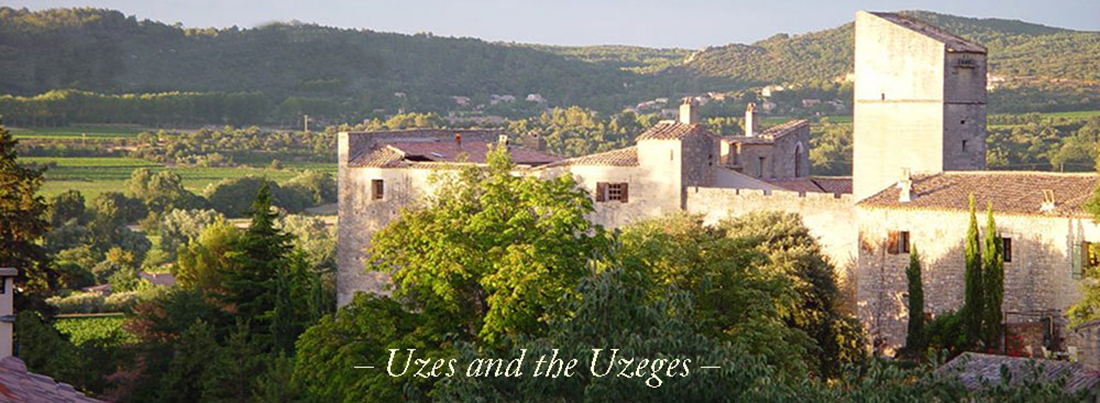
What is an Abrivado?
They’re free. They’re fantastic. And they’re cultural. If you have a chance while you’re in the Uzes, France area—most definitely try and see an abrivado!
In spite of our having travelled to France for decades, we didn’t have the slightest idea what an abrivado was. That’s because they’re strictly local affairs, and the smaller the village holding them, the better they are.
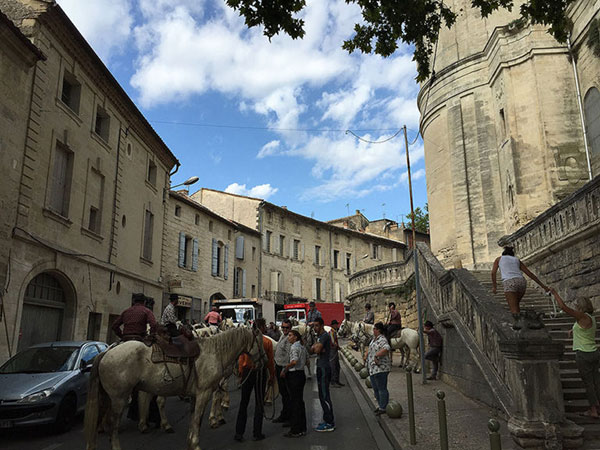
The story begins in the Camargue, a delta which lies at the mouth of the Rhone river. It’s a flat, marshy area known for the salt that is harvested there, its wonderful rice, and the jet-black Camargue bulls that are the stars of Course Camarguaises (to be covered in one of the next posts).
Also cowboys…known as guardiens.
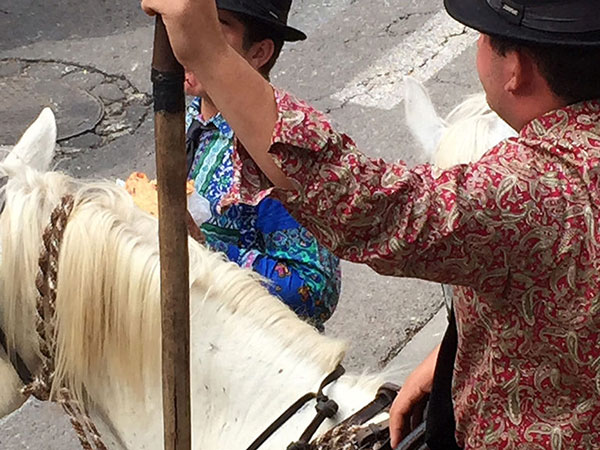
Guardiens wear natty black hats and prettily-patterned, quite floral, long-sleeved shirts. The brighter the color and busier the patter, the better, it seems. They also prefer riding white horses, which as as renowned as the region’s bulls.
In the Camargue, it seems, the men are pretty, the bulls are black, and the horses are supposed to be white.
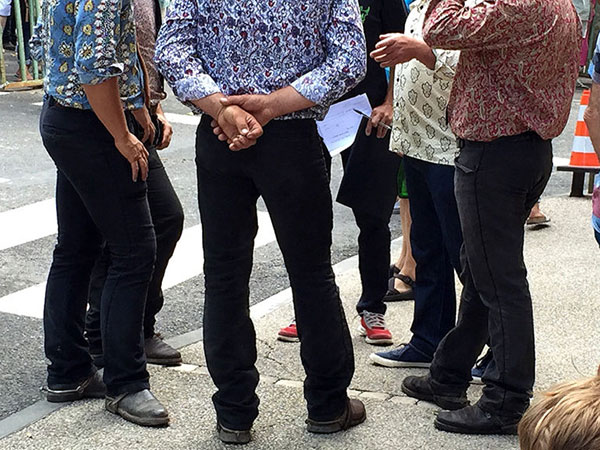
Guardiens also wear ridiculously narrow “skinny” jeans. Colored black, of course. Their colorful shirts may billow in the breeze, but their pants never do.
As was said in the beginning, abrivados are incredibly exciting and wonderfully cultural. And they can also be funny…
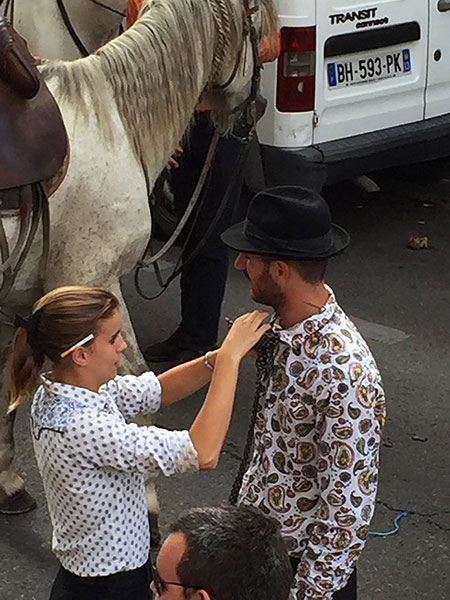
In Uzes a few years ago, we saw a young French woman busily tying her boyfriend’s necktie. (The cigarette tucked behind her ear instantly gives away her nationality. And then a friend appears…
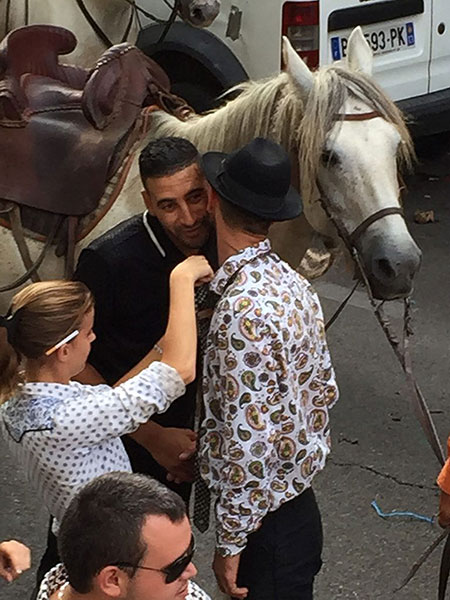
What to do? Your tie’s only half tied. You return the kiss in greeting, of course! It would be rude not to. (Note too, the handshake and kiss combination.)
And your girlfriend? She dutifully keeps tying your tie the whole time.

Abrivados are extremely popular, and the one in Uzes drew a large crowd. We much prefer the smaller town versions, which tend to strictly be local affairs. They seem more fun, and it’s much easier to get close to the action.
And then it begins…
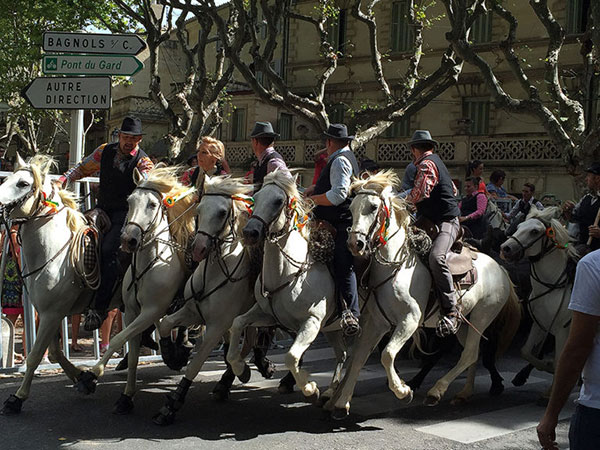
A group of guardiens first lead six to eight Camargue bulls at a mad gallop down the street. The sound of the hooves on the pavement is quite loud, and the speed at which they do so is impressive. And then it gets quiet again.
After a while, the guardiens casually ride back up the street, which might lead first-time abrivadoers to wonder if it was all done with.
But no one leaves. Mothers and fathers, children, grandfathers and grandmothers (they really are for tout la famille), as well as a few village dogs, remain behind the metal barricades that block off the street.
Then you hear a staccato-like sound…the guardiens reappear…and your mouth will fall open in amazement.
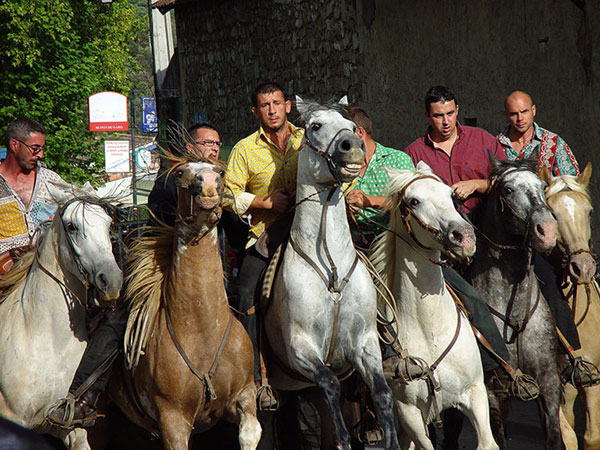
They ride in a compact group, with an ornery Camargue bull tucked tight behind the horses. It’s a jerky-jerky kind of thing, surging and faltering, twisting and turning. Chaotic. Noisy. A smidge beyond being totally out of control.
The horse’s manes fly wild in the air, and the guardiens regularly look nervously behind them to make sure that the bull stays bunched tight behind the horses. This is important, because every now and then a bull gets loose and somehow works its way behind the barricades. During the abrivado in Uzes, this happened, and an inattentive British tourist was trampled, but thankfully not hurt other than to his pride. (It was an impressive bit of trampling, though: a thick of dust; a shoe that tumbled down the road, and a white hat which floated on the air.)
The guardiens become extremely upset whenever this happens. They take it as a blot on their horsemanship, an insult to their ability to control the bull.
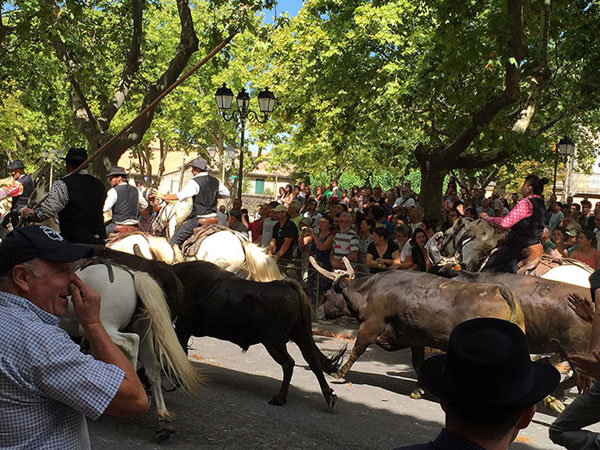
And then the best part of an abrivado takes place. It’s not just a horse and bull show, because at a specific spot, young boys have been waiting.
When the horse and bull phalanx appears, the teens dash in and try to grab the bull, working their way through the bulk and hooves of the horses…and it should be added…the bulk and hooves and horns (!) of the bull.
The boys win if they can bring the bull to a halt. If they fail, they regroup and await the next bull. A dozen or so bulls are run down the street, giving the boys ample opportunity to win village-based fame and renown.
But no one ever suggested this was going to be easy…
From The Book:
Chapter 38: Where Hoof Meets Flesh
And then we learned what an abrivado was.
A swarm of teenaged boys surged forward and threw themselves at the bull like hungry locusts on a green leaf. It was amazing. The bull kicked savagely with its hooves and sent several of the boys tumbling, and when it was able to separate itself from the horses for an instant, it swung its horns aggressively at any who dared approach from the side.
Several young men managed to grab the bull by the neck and held on for dear life. At the back of the tumult, an overweight T-shirted teen held the bull’s tail in both hands and leaned back hard, his heels digging into the street as he was dragged along, the bull’s tail so taut that we feared it might snap off.
The young men were determined and courageous…but massively outweighed. Out-horned, too, and several were sent flying like pins at a bowling alley. We saw the soles of a pair of white tennis shoes appear, hanging upside down, cartoon-like, in the dust and air above the bull and horse conglomeration, and then the teen that was attached to them slipped beneath the tangle of horse and bull hooves and disappeared from view.
Unbelievable…
TIPS:
• Abrivados are part of summertime fetes de village (village celebrations), so they’re not widely published. Ask at the Uzes tourist office where you can find one nearby. Tell them you’d prefer to take in an abrivado at a smaller village. (This won’t please the tourist bureau any, but the one in Uzes just doesn’t have the same local color.)
• If you have children with you, keep an eye on them. It’s rare, but people do get hurt at these things. And quite obviously—though it needs to be said—stay behind the barricades.
